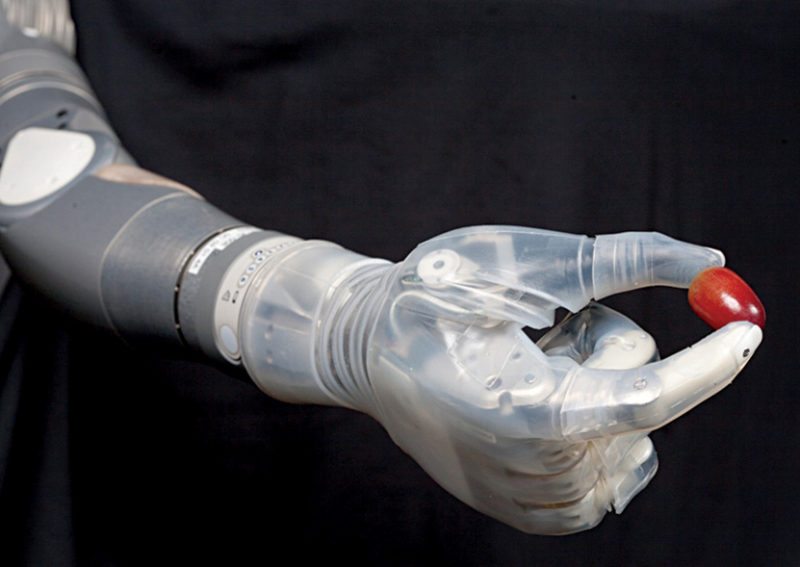
The technology is extremely promising, and even if the vehicle never makes it to the street as a legal, safe and affordable car, the sensors and innovations coming out of the project are sure to help in other areas. Not only could this serve as a means of independent, safe transportation for the visually impaired, but also for many individuals with physical and mental handicaps that prevent them from operating a motor vehicle. Whether it is further study of brain re-mapping and alternate sensory input, practical implications of better sensors and safety devices that can be applied to all motor vehicles or an all-out safe and practical means of driving blind, this technology excites many.
A group of researchers have developed a highly-sophisticated, highly-functional prosthetic arm and the results are amazing—a less-than-3.6kg prosthetic arm with such precision and control that it can peel a grape. The arm supports a number of customisable controls and modular components, making it easy to tailor to the wearer’s individual needs, whether he or she requires only a hand or an entire arm and shoulder socket.
Another promising feature of the arm is its sensory feedback system. Hand sensors measure the strength of the hand grip, for instance, and provide feedback to the wearer in the form of vibrations that grow stronger as the strength of the grip increases. This enables the wearer to learn what level of grip strength is appropriate for specific tasks and how much pressure is being applied.
Development on the cochlear implant first began in the late 1950s, and the first commercial implant device received approval in 1984. However, cochlear implants have come a long way. Initially, the single-channel implant provided mostly static, while early commercial implants with five channels allowed for some indication of cadence and rhythm.
Today’s cochlear implants, however, have more than 20 sound channels, allowing wearers to hear with much better quality. The implants are still far from perfect, with background noise continually being a problem, but the technology has advanced to such a point now that voices can be heard with enough clarity to be readily understood and identified, making verbal communication possible and productive.
Cochlear implants are pretty amazing and only grow more so as the software and hardware continue to improve. More than just a hearing aid, these first pick up a sound via a microphone, which carries the signal to a small computer worn behind the ear, where it is transferred to a digital signal and transmitted to the implant itself. Once received by the implant, the device directly stimulates the auditory nerve, providing an entirely new means of auditory sensory input.
Stairs are nearly everywhere and navigating these in a traditional wheelchair is impossible. Enlisting the services of others to drag or carry the person up and down the stairs is dangerous, inconvenient and often embarrassing. iBot is a self-balancing, stair-climbing wheelchair for the physically disabled. Using self-balancing technology, it aims to give wheelchair-bound individuals the freedom to navigate any terrain.
Advancements in wearable technology enable people with disabilities to carry on with everyday functions. Winkymote is an infrared remote control hidden in make-up that helps quadriplegics change TV channels by blinking. This development has grown to include metalised false eyelashes that can activate various electronic devices and other cosmetics tech products.
People with epilepsy experience seizures at any time, often without warning. In May 2013, senior engineering students at Rice University in Texas developed Seizure Monitoring and Response Transducer (SMART) belt to detect signs of seizures. This belt can also wirelessly send messages to guardians or caretakers. It is meant for people aged six and above, and is still under development (at the time of this writing).
There are mobile phones with Braille number keys, but what about touchscreen smartphones? Researchers are developing a phone with a screen comprising a grid of pins. When the user receives a message, the pins form shapes and characters using shape memory alloy technology.
With Lucy 4 keyboard, people with limited or no use of their hands can operate a computer. The user mounts a battery-operated laser pointer on the glasses or headband and selects keys on the custom stand-up keyboard. A woman named Janine who has cerebral palsy created Lucy and even created a website and an introductory video using her invention. Lucy 4 keyboard allows people with disabilities to compute, while lessening fatigue.
DynaVox’s EyeMax uses eye-tracking technology for computing, watching television, reading books and speaking for people with limited mobility. EyeMax’s camera tracks the user’s eye movements, allowing him or her to use the device simply by blinking or gazing.
The form of home automation called assistive domotics focuses on making it possible for the elderly and disabled to remain at home, safe and comfortable. Home automation is becoming a viable option for the elderly and disabled who prefer to stay in the comfort of their homes rather than move to a healthcare facility. This field uses much of the same technology and equipment as home automation for security, entertainment and energy conservation but tailors it for the elderly and the disabled.
Home robots are helpful for people who cannot easily clean their homes with traditional equipment. These use localised navigation to clean their environments thoroughly.
Bionic devices are revolutionising prosthetics, giving users more control.
Google Glass is often seen as a gadget for tech-savvy geeks who want to remain connected at all times, but Catalin Voss is working to create face-tracking software for the augmented reality glasses. It is a tool for users with autism and related disorders. The face-tracking engine helps people better recognise and understand others’ facial expressions and, in turn, their emotions.











“At present, Hawking is at Dennis Stanton Avery and Sally Tsui Wong Avery, as director of research at Department of Applied Mathematics and Theoretical Physics and founder of Centre for Theoretical Cosmology at Cambridge”.
I’m sorry to remind you that Hawkins died in 2018